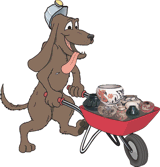|
Carved:
decoration cut deeply into a pot.
Corrugated: pottery with rows of little indentation on its
surface.
Fillet: rope of clay that is coiled on a base to create
the walls of a pot.
Fire Cloud: dark smudge on a pot that was fired outdoors,
caused by a piece of burning fuel touching the pot.
Fired: baked at a high temperature.
Greenware:
unfired
clay objects, mass-produced in molds.
Guaco: a paint made by boiling beeweed.
Heartline:
painted arrow leading from the mouth into the chest of an animal
motif.
Incised: fine lines scratched through the surface of an
unfired pot.
Kaolin: very fine, soft white clay.
Leather Hard:
stage of dryness at which an unfired pot is no longer malleable.
Line Break: gap left in an encircling line.
Melon Bowl: rounded bowl with thick, vertical ribs.
Mudheads: ceremonial clowns.
Ollas: Spanish for “pots”.
Oxidizing atmosphere:
the condition in which air is allowed to reach the pot throughout
the firing process.
Paste:
mixture of clay and temper.
Polychrome:
painted with various colors.
Pueblo: Spanish for “people” or “town.” Now, the
traditional people of the Rio Grande and the Jémez River valleys
as well as Laguna, Ácoma, Zuni, and Hopi.
Puki: bowl-shaped object used to support the curved bottom
of a pot.
Reducing atmosphere:
occurs when oxygen is kept from pottery during firing.
Sgraffito: decoration scraped very shallowly into a pot’s
surface.
Sherd: piece of broken pottery; sometimes spelled shard to
reflect the British pronunciation.
Slip: liquid clay applied over a pot to smooth and/or
color it. Some slips have an important chemical reaction with
certain paints.
Smothering: covering the pots with powdered fuel—usually
manure—during firing.
Split rectangles:
design element in which a rectangle is divided in half
diagonally and each half is decorated differently.
Temper:
gritty material added to clay to
prevent a piece from shrinking or breaking as it dries or is
fired.
Turkey eyes:
design element consisting of a dot encircled by white space
bordered by a dark color.
Yucca: very fibrous evergreen plant that grows throughout
the
Southwest, used by some potters as a paintbrush |
 ClayHound Web
- The Quest
ClayHound Web
- The Quest ClayHound Web
- The Quest
ClayHound Web
- The Quest